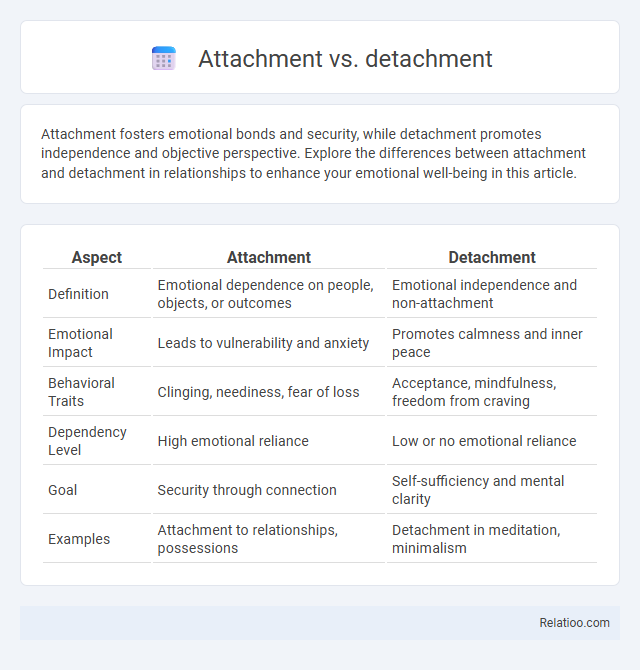Attachment fosters emotional bonds and security, while detachment promotes independence and objective perspective. Explore the differences between attachment and detachment in relationships to enhance your emotional well-being in this article.
Table of Comparison
| Aspect | Attachment | Detachment |
|---|---|---|
| Definition | Emotional dependence on people, objects, or outcomes | Emotional independence and non-attachment |
| Emotional Impact | Leads to vulnerability and anxiety | Promotes calmness and inner peace |
| Behavioral Traits | Clinging, neediness, fear of loss | Acceptance, mindfulness, freedom from craving |
| Dependency Level | High emotional reliance | Low or no emotional reliance |
| Goal | Security through connection | Self-sufficiency and mental clarity |
| Examples | Attachment to relationships, possessions | Detachment in meditation, minimalism |
Understanding Attachment: Definition and Types
Attachment refers to the emotional bond formed between individuals, rooted in security and trust, essential for healthy relationships. Types of attachment include secure, anxious, avoidant, and disorganized, each influencing emotional responses and interpersonal behavior uniquely. Detachment involves emotional withdrawal or disengagement, while emotional distance denotes a perceived lack of closeness or connection, often complicating relational dynamics.
The Psychology Behind Detachment
Detachment in psychology refers to a conscious process where you create emotional boundaries to protect your mental well-being, contrasting with attachment which involves deep emotional investment. Emotional distance often emerges as a defense mechanism to reduce vulnerability but can lead to feelings of isolation if prolonged. Understanding the balance between healthy detachment and emotional engagement is key to maintaining stable relationships and personal resilience.
Key Differences: Attachment vs Detachment
Attachment involves forming strong emotional bonds that foster closeness and dependence, often driven by the desire for security and connection. Detachment, in contrast, is characterized by emotional disengagement and self-protection, enabling individuals to maintain independence and reduce vulnerability. Emotional distance refers to the perceived or actual space in relationships, which can stem from unhealthy detachment or poor communication, differing from attachment's intimacy and detachment's intentional separation.
Emotional Benefits of Healthy Attachment
Healthy attachment fosters emotional security, enabling you to build trust and experience deeper connections with others. Unlike detachment or emotional distance, it promotes resilience and provides a reliable support system during stress or challenges. This secure bond enhances your overall well-being by reducing anxiety and encouraging positive emotional expression.
Advantages of Practicing Detachment
Practicing detachment enhances emotional resilience by allowing you to experience situations without becoming overwhelmed by intense feelings, promoting clearer decision-making. It fosters inner peace and reduces stress, helping you maintain a balanced perspective even in challenging relationships or environments. Emotional distance, when balanced, supports healthier boundaries, preventing codependency while maintaining meaningful connections.
When Attachment Becomes Unhealthy
When attachment becomes unhealthy, it often leads to emotional dependency, where your sense of self-worth hinges on another person's approval or presence, causing anxiety and insecurity. Emotional distance may be interpreted as detachment but differs by involving conscious self-protection rather than avoidance of emotional bonds. Recognizing unhealthy attachment patterns ensures you maintain balanced connections and emotional well-being.
Signs of Excessive Detachment
Excessive detachment often manifests through persistent emotional numbness, avoidance of close relationships, and a lack of empathy toward others' feelings. Individuals displaying these signs may struggle with forming deep connections, exhibit indifference to significant life events, and experience difficulties in expressing or recognizing emotions. Such detachment can hinder personal growth and contribute to long-term social isolation and mental health challenges.
Balancing Attachment and Detachment for Well-being
Balancing attachment and detachment is crucial for emotional well-being, as excessive attachment can lead to dependency while extreme detachment may cause isolation and emotional numbness. Healthy emotional distance allows individuals to maintain personal boundaries and self-awareness, fostering resilience and stable relationships. Developing mindful attachment practices supports emotional regulation, enabling a dynamic equilibrium between connection and autonomy.
Strategies to Cultivate Healthy Relationships
Cultivating healthy relationships involves balancing attachment and detachment while managing emotional distance effectively. Strategies such as practicing open communication, setting clear boundaries, and fostering mutual respect help you maintain emotional intimacy without losing individual autonomy. Prioritizing self-awareness and empathy supports connection, allowing relationships to thrive without unhealthy dependency or excessive withdrawal.
Achieving Personal Growth Through Balance
Achieving personal growth requires balancing attachment, detachment, and emotional distance to nurture healthy relationships while maintaining self-awareness. Attachment fosters connection and empathy, detachment allows objective perspective and resilience, and emotional distance protects your well-being without fostering isolation. You can develop emotional intelligence by recognizing when to engage deeply and when to create space for reflection and self-care.

Infographic: Attachment vs detachment
 relatioo.com
relatioo.com